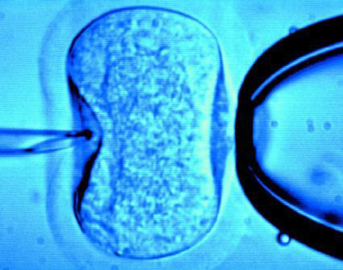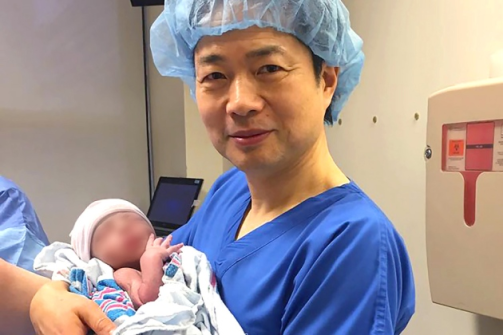The beaming doctor is New York City fertility specialist Dr. John Zhang. He is holding a newborn – swaddled in the ubiquitous teal-and-raspberry striped labor and delivery blanket. The new little boy with the blurred-out face is world famous. Not since Louise Brown (the world’s first “test tube” baby) was born in 1978 has a newborn made such headlines. In vitro fertilization doesn’t even rate a yawn today, but this little boy (who is actually now five months old) has been simultaneously heralded as hope for parents AND a scene right out of the science fiction movie Gattaca.
He’s the world’s first three-parent baby.
The baby’s mother carries a genetic mutation for Leigh syndrome, a devastating and fatal disorder. The couple lost their first two children to Leigh syndrome and suffered multiple miscarriages. Leigh syndrome is a “mitochondrial disorder”, a large group of disorders that range from asymptomatic to fatal.
Mitochondria, nicknamed “the powerhouses of the cell”, are the structures in our cells that convert the food we eat to energy. When mitochondria are defective, it is not surprising that high-energy needs systems are targeted: the central nervous system, the respiratory system, the heart, the muscles, and the eyes.
Mitochondrial disorders are only passed from mother to child – never from father to child. At this point, we fall down a fascinating science-rabbit hole that involves alien hitchhikers inside you, evolution, deep time, and a happy family with a healthy baby boy.
Mommy’s Little Mitochondria
All of the mitochondria in the cells of your body – every last one of them – came from your mother. Cells have a central control center (the nucleus) that contains your genetic code – the genes you inherited from both your mother and father. Everything else in the cell (including the mitochondria) is floating around in the liquid cytoplasm outside the nucleus.
Both eggs and sperm have nuclei; both eggs and sperm have liquid cytoplasm. BUT – at the point of fertilization, only the nucleus of the sperm enters the egg to fertilize it. What’s the result? A fertilized egg with genetic information from both egg and sperm, but liquid cytoplasm from only the mother. And because mitochondria are found in the cytoplasm, mitochondria are all from the mother.
Mitochondria: Doing it for Themselves
Mitochondria are unlike any of the other tiny structures floating around in the cytoplasm of your cells. Your body grows and repairs itself because cells divide. Mitochondria, however, divide independently of the cell in which they are located. Mitochondria do their own thing, whether or not the cell they are in is dividing. Other cell structures are formed as new cells are formed. But not our little independent mitochondria. All the mitochondria in your body are descendants of the mitochondria originally present in the cytoplasm of your mother’s egg.
And that’s not all that sets mitochondria apart from all the other cell parts. Mitochondria have their very own tiny little genomes – their very own collection of 37 genes not found in the nucleus of the cells. It is this tiny little genome that controls the critical energy-generating functions of the mitochondria. And it is in this tiny little genome where devastating mutations can occur – mutations that lead to fatal mitochondrial disorders like Leigh syndrome.
Alien Hitchhikers in your Body
I’ll get back to the story of the first three-parent baby; but first we need to take a little trek back into deep time.
The first living organisms were very simple single cells. These cells had genetic material (DNA) but very few specialized cell structures. These early organisms included bacteria and the ancestors of modern complex cells.
About two billion years ago, a free-living bacterium (who was particularly efficient at generating energy from food) was engulfed by another free-living cell (probably as a meal). But instead of being digested, the little high-energy bacterial hitchhiker set up housekeeping inside the cell.
The host cell took advantage of the energy generated by the bacterium, and the bacterium benefited from the food consumed by the host cell. In biology, this perfect roommate situation is called endosymbiosis.
Because both the host cell and the high-energy bacterium were distinct individuals, they reproduced independently. When it came time to reproduce, the high-energy bacterium pinched in half – the way all bacteria divide. Those new bacteria also divided, and before long there was a small population of bacteria happily dwelling within a free-living cell. When the host cell divided into two new cells, some of the bacterial offspring went to one new cell, the rest of the bacteria to the other new cell.
For the next two billion years, the descendants of the high-energy bacterium and the original host cell lived on as happy roommates. All multicellular organisms (including humans) and all single-celled organisms with a nucleus evolved from an ancient ancestral cell who lived in harmony with a powerful internal roommate.
The Evidence
In the 1960s, biologist Lynn Margulis noticed that mitochondria, the “powerhouse” of the cell, looked and acted just like free-living bacteria:
Mitochondria have their own double-layer cell membrane – just like bacteria.
Mitochondria have their own separate DNA. But instead of the familiar linear chromosomes, mitochondrial DNA is looped or circular – just like bacteria.

evolution.berkeley.edu
Mitochondria reproduce by pinching in half – just like bacteria. If all of the mitochondria are destroyed in a cell, the cell is unable to build new ones from scratch. Mitochondria only come from other mitochondria.

evolution.berkeley.edu
We now know that endosymbiosis has occurred many times in the history of life, most famously with mitochondria and also with the photosynthesizing chloroplasts in the cells of green plants.
Mommy, Daddy, and Mitochondrial Mom

popsi.com
Just like any routine in-vitro fertilization, the baby boy in this case began his life in a petri dish. But before his mom’s egg was fertilized with his dad’s sperm, there was a preliminary step.
The nucleus was removed from the mother’s egg. Next, the nucleus was removed from a donor egg with healthy mitochondria. The nucleus from the mother was then placed in the donor egg. The egg was then fertilized in-vitro with sperm from the father.
The result? A healthy baby boy with DNA from his mother and father, and a tiny fraction of mitochondrial DNA from a donor egg.
Understanding the evolutionary history of the mitochondria explains why mitochondrial DNA can be defective, even if the parents’ primary genomes are free of genetic disease.
In the United States, the FDA must approve such procedures before they can be legally carried out. Because the FDA has yet to do so, this IVF with a mitochondrial donor was done in Mexico. The United Kingdom approved IVF with mitochondrial donation in 2015, but as of yet, no babies have been born using this procedure.
*****
The heavens declare the glory of God;
the skies proclaim the work of his hands.
Day after day they pour forth speech;
night after night they reveal knowledge
*****

Science Cat

I just discovered “Scientific Songs of Praise”. Nana, Mom, and kids watched several of them today.
https://www.youtube.com/channel/UCeMZ98B_0RXAZDOaKP_NfgA
“Single Cells, Single Cells” is the one pertaining to *”About two billion years ago, a free-living bacterium (who was particularly efficient at generating energy from food) was engulfed by another free-living cell (probably as a meal). But instead of being digested, the little high-energy bacterial hitchhiker set up housekeeping inside the cell.”*